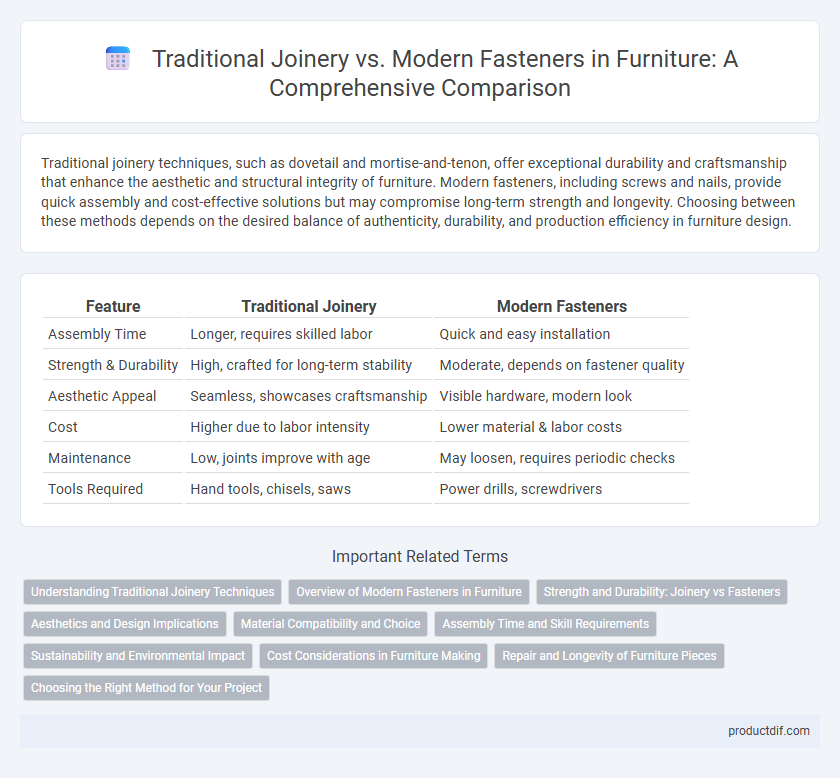Traditional joinery techniques, such as dovetail and mortise-and-tenon, offer exceptional durability and craftsmanship that enhance the aesthetic and structural integrity of furniture. Modern fasteners, including screws and nails, provide quick assembly and cost-effective solutions but may compromise long-term strength and longevity. Choosing between these methods depends on the desired balance of authenticity, durability, and production efficiency in furniture design.
Table of Comparison
| Feature | Traditional Joinery | Modern Fasteners |
|---|---|---|
| Assembly Time | Longer, requires skilled labor | Quick and easy installation |
| Strength & Durability | High, crafted for long-term stability | Moderate, depends on fastener quality |
| Aesthetic Appeal | Seamless, showcases craftsmanship | Visible hardware, modern look |
| Cost | Higher due to labor intensity | Lower material & labor costs |
| Maintenance | Low, joints improve with age | May loosen, requires periodic checks |
| Tools Required | Hand tools, chisels, saws | Power drills, screwdrivers |
Understanding Traditional Joinery Techniques
Traditional joinery techniques such as mortise and tenon, dovetail, and finger joints rely on precise wood-to-wood connections that enhance furniture durability and aesthetic appeal. These methods use interlocking parts without the need for metal fasteners, ensuring long-lasting structural integrity and timeless craftsmanship. Mastering these skills allows woodworkers to create robust furniture pieces that maintain their strength and beauty over generations.
Overview of Modern Fasteners in Furniture
Modern fasteners in furniture, such as screws, nails, dowels, and cam locks, provide efficient and reliable assembly solutions compared to traditional joinery methods like mortise and tenon or dovetail joints. These fasteners enable quicker construction, easier disassembly, and cost-effective manufacturing while maintaining structural integrity and durability. Innovations in materials and design, including corrosion-resistant coatings and adjustable connectors, enhance the versatility and longevity of modern fastened furniture.
Strength and Durability: Joinery vs Fasteners
Traditional joinery techniques such as dovetail, mortise-and-tenon, and finger joints create strong, interlocking connections that distribute stress evenly, resulting in exceptional durability and long-lasting furniture. Modern fasteners, including screws, nails, and brackets, offer quicker assembly but may concentrate stress at fastening points, potentially leading to loosening or failure over time. Furniture built with traditional joinery often outperforms fastener-based pieces in strength and resistance to wear, making it ideal for heirloom-quality items.
Aesthetics and Design Implications
Traditional joinery techniques such as dovetail and mortise-and-tenon provide seamless, intricate connections that enhance the visual appeal and craftsmanship of furniture pieces. Modern fasteners like screws and metal brackets offer quicker assembly but often result in visible hardware that can detract from the clean lines and refined aesthetics. Designers must balance the authenticity and elegance of traditional joinery with the convenience and cost-effectiveness of modern fasteners to achieve desired stylistic outcomes.
Material Compatibility and Choice
Traditional joinery techniques, such as dovetail and mortise-and-tenon, excel in compatibility with solid wood, preserving structural integrity without relying on metal components that may cause corrosion or weakening over time. Modern fasteners like screws, nails, and brackets offer versatility across various materials including plywood, MDF, and composites, enabling faster assembly but sometimes compromising long-term durability in hardwood applications. Selecting between traditional joinery and modern fasteners depends on material type, desired strength, aesthetic preference, and the specific furniture design requirements.
Assembly Time and Skill Requirements
Traditional joinery techniques such as mortise and tenon or dovetail joints demand advanced woodworking skills and significantly longer assembly times compared to modern fasteners like screws, dowels, and cam locks. Modern fasteners streamline the construction process, allowing for quicker assembly with minimal expertise, making them ideal for mass production and ready-to-assemble furniture. The trade-off involves balancing the craftsmanship and durability of traditional joinery against the efficiency and convenience of modern fastening methods.
Sustainability and Environmental Impact
Traditional joinery techniques, such as mortise and tenon or dovetail joints, rely on precise craftsmanship and natural materials, minimizing the use of metal fasteners and synthetic adhesives, which contributes to lower environmental impact. These methods promote durability and repairability, extending the furniture's life cycle and reducing waste compared to modern fasteners that often complicate recycling. Modern fasteners, typically made from metal or plastic, increase production speed but raise concerns regarding resource depletion and recyclability, making traditional joinery a more sustainable choice for environmentally conscious furniture design.
Cost Considerations in Furniture Making
Traditional joinery techniques in furniture making often require skilled craftsmanship and more labor time, increasing initial production costs. Modern fasteners, such as screws and brackets, reduce assembly time and lower labor expenses but may involve higher material costs due to specialized hardware. Evaluating these factors helps manufacturers balance budget constraints while maintaining structural integrity and aesthetic quality.
Repair and Longevity of Furniture Pieces
Traditional joinery techniques, such as dovetail and mortise-and-tenon joints, provide superior strength and repairability, allowing furniture to withstand generations of use with minimal structural degradation. Modern fasteners like screws and nails offer ease of assembly but often compromise long-term durability, as metal components may loosen or corrode over time, complicating repairs. Repairing furniture with traditional joinery preserves the original craftsmanship, ensuring longevity and maintaining structural integrity through multiple restorations.
Choosing the Right Method for Your Project
Selecting the appropriate joinery method hinges on the project's aesthetic, durability requirements, and assembly complexity. Traditional joinery techniques like mortise and tenon provide superior strength and timeless elegance but require skilled craftsmanship and longer fabrication time. Modern fasteners, including screws and brackets, offer ease of installation and cost-effectiveness, making them ideal for quick assembly and projects with less structural load.
Traditional joinery vs Modern fasteners Infographic

 productdif.com
productdif.com